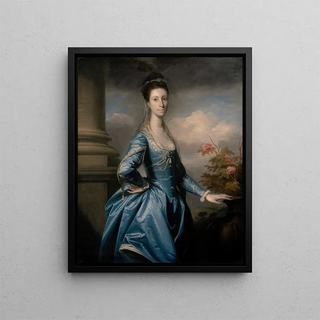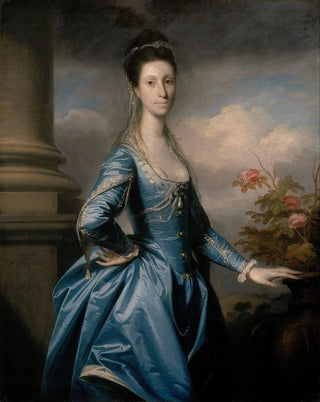Art print | Mademoiselle Elizabeth Ingram - Sir Joshua Reynolds Source: Reproduction | Mademoiselle Elizabeth Ingram - Sir Joshua Reynolds


View from behind

Frame (optional)
Sir Joshua Reynolds's "Mademoiselle Elizabeth Ingram" is an iconic 18th-century art print that embodies both the elegance and refinement of the Georgian era. This depiction of a young woman, imbued with grace and dignity, immerses us in a universe where beauty and social status blend harmoniously. Reynolds, a master of portraiture, captured not only the physical appearance of his model but also the very essence of her personality. Through this art print, the artist invites us to explore the subtleties of female identity during a time marked by strict conventions and precise social expectations.
Style and uniqueness of the art print
Reynolds's style is distinguished by his masterful use of light and color. In "Mademoiselle Elizabeth Ingram," delicate hues and subtle nuances create an almost ethereal atmosphere, highlighting the softness of the young woman's face. The drapery of her dress, carefully rendered, seems to vibrate under the light, adding a tactile dimension to the composition. Every detail, from the sparkling jewelry to the contemplative expression in her gaze, helps tell a story—of a woman both strong and vulnerable. The artist manages to transcend the simple portrait to offer a reflection on beauty and the passage of time, inviting the viewer to contemplate not only the image but also the underlying narrative.
The artist and his influence
Sir Joshua Reynolds, a prominent figure in British portraiture, left a lasting mark on his era through his ability to combine technique and sensitivity. As the first president of the Royal Academy, he played a crucial role in promoting the arts in England, influencing generations of artists. His innovative approach, blending realism with a certain idealization, paved the way for new perspectives in portrait art. Through his works, he gave a voice to women of his time, offering them visibility and recognition often absent in the patriarchal society of the period. "Mademoiselle Elizabeth Ingram" is a perfect example of this approach, revealing the psychological depth of his model while respecting artistic conventions.

Matte finish

View from behind

Frame (optional)
Sir Joshua Reynolds's "Mademoiselle Elizabeth Ingram" is an iconic 18th-century art print that embodies both the elegance and refinement of the Georgian era. This depiction of a young woman, imbued with grace and dignity, immerses us in a universe where beauty and social status blend harmoniously. Reynolds, a master of portraiture, captured not only the physical appearance of his model but also the very essence of her personality. Through this art print, the artist invites us to explore the subtleties of female identity during a time marked by strict conventions and precise social expectations.
Style and uniqueness of the art print
Reynolds's style is distinguished by his masterful use of light and color. In "Mademoiselle Elizabeth Ingram," delicate hues and subtle nuances create an almost ethereal atmosphere, highlighting the softness of the young woman's face. The drapery of her dress, carefully rendered, seems to vibrate under the light, adding a tactile dimension to the composition. Every detail, from the sparkling jewelry to the contemplative expression in her gaze, helps tell a story—of a woman both strong and vulnerable. The artist manages to transcend the simple portrait to offer a reflection on beauty and the passage of time, inviting the viewer to contemplate not only the image but also the underlying narrative.
The artist and his influence
Sir Joshua Reynolds, a prominent figure in British portraiture, left a lasting mark on his era through his ability to combine technique and sensitivity. As the first president of the Royal Academy, he played a crucial role in promoting the arts in England, influencing generations of artists. His innovative approach, blending realism with a certain idealization, paved the way for new perspectives in portrait art. Through his works, he gave a voice to women of his time, offering them visibility and recognition often absent in the patriarchal society of the period. "Mademoiselle Elizabeth Ingram" is a perfect example of this approach, revealing the psychological depth of his model while respecting artistic conventions.






